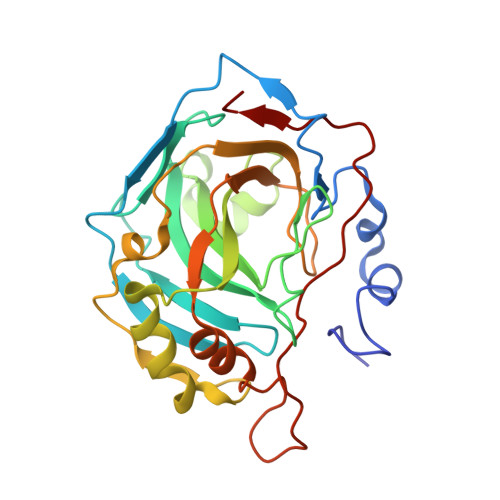Proton transfer in a Thr200His mutant of human carbonic anhydrase II
Bhatt, D., Tu, C., Fisher, S.Z., Hernandez Prada, J.A., McKenna, R., Silverman, D.N.(2005) Proteins 61: 239-245
- PubMed: 16106378
- DOI: https://doi.org/10.1002/prot.20615
- Primary Citation of Related Structures:
1YO0, 1YO1, 1YO2 - PubMed Abstract:
Human carbonic anhydrase II (HCA II) has a histidine at position 64 (His64) that donates a proton to the zinc-bound hydroxide in catalysis of the dehydration of bicarbonate. To examine the effect of the histidine location on proton shuttling, His64 was replaced with Ala and Thr200 replaced with histidine (H64A-T200H HCAII), effectively relocating the proton shuttle residue 2 A closer to the zinc-bound hydroxide compared to wild type HCA II. The crystal structure of H64A-T200H HCA II at 1.8 A resolution shows the side chain of His200 directly hydrogen-bonded with the zinc-bound solvent. Different proton transfer processes were observed at pH 6 and at pH 8 during the catalytic hydration-dehydration cycle, measured by mass spectrometry as the depletion of 18O from C18O2 by H64A-T200H HCA II. The process at pH 6.0 is attributed to proton transfer between the side chain of His200 and the zinc-bound hydroxide, in analogy with proton transfer involving His64 in wild-type HCA II. At pH 8.0 it is attributed to proton transfer between bicarbonate and the zinc-bound hydroxide, as supported by the dependence of the rate of proton transfer on bicarbonate concentration and on solvent hydrogen isotope effects. This study establishes that a histidine directly hydrogen-bonded to the zinc-bound hydroxide, can adopt the correct distance geometry to support proton transfer
Organizational Affiliation:
Department of Pharmacology and Therapeutics University of Florida, Gainesville, Florida 32610-0245, USA.
















